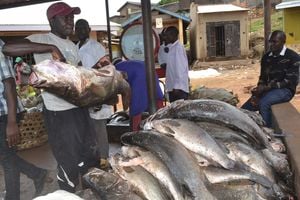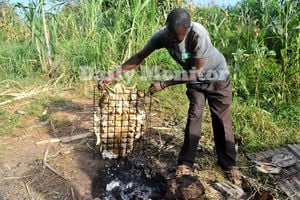
A 65Kgs Nile Perch from Lake Victoria in this photo taken on October 17, 2019
The concerns follow various scientific surveys which show that while the population of small pelagic fish species such as silver fish—known as dagaa in Tanzania, mukene in Uganda, and omena in Kenya—is growing,Nile perch—a cash cow of Kenya, Tanzania and Uganda economies—has been declining.
In the previous six years to 2023, export data from the directorate of fisheries industry in the Ministry of Agriculture, Animal Industry and Fisheries (Maaif) shows that Nile perch and its maws raked in more than $960 million (about Shs3.5b) for Uganda. As many as 104,624 tonnes were exported during the period, amid the declining population of the large predatory fish.
What numbers are we dealing with here?
A 2022 hydro-acoustic study of the sound of the entire Lake Victoria carried by the East Africa Community’s Lake Victoria Fisheries Organisation (LVFO) on commercial fish species in Lake Victoria turned up some fascinating numbers.
Standing stock was 2.23 million metric tonnes,20 percent lower than that recorded during the 2021 survey.
Silverfish constituted 47 percent of the standing stock, followed by Caridinanilotica 23 percent, haplochromines—fulu in the Luo language; furu in Swahili; and nkejje in Luganda—mustered 15 percent as did Nile perch (15 percent).
The mean standing stock of Nile perch was 333,341 tonnes, which is equivalent to annual biomass (production) of 736,683 tonnes.
This biomass was 33.72 percent lower than that in 2021. The mean standing stock of dagaa was 1,060,589 tonnes, which is equivalent to annual biomass of 4,189,327 tonnes, 14.3 percent on average higher than that from 2021.
Ms Daisy Aciro, the assistant commissioner of the Directorate of Fisheries, attributed the significant disparity between the silverfish and Nile perch populations to a conflict over water resource usage between the two fish species.
“Concerns have been raised over the impact of silverfish harvesting technologies on Nile perch stocks, with main issues being competition for fishing grounds, harvesting of juveniles of large fish,and damage to fishing gears of Nile perch fishers.
On the other hand, some of the Nile perch fishers use drift nets that interfere with fishing silverfish,”she told this publication.
What questions are at play?
The question is whether the environ mental watchdog National Environment Management Authority (Nema) is part of a perceived conspiracy to cause economic sabotage in Uganda. Another school
of thought insists that some foreign elements do not want to allow the Ugandan economy to grow. The outrage on either side of what is conjectured is based on supposition and hearsay.
Regardless, the downstream players’ fears have grown over time after seeing hundreds of fishermen taking advantage of weak regulatory and administrative measures meant to stop bad fishing.
The aforesaid fishermen continue deliberately using prohibited nets in Uganda’s waters, which have contributed to the sharp decline of the Nile perch population.
For years, enforcement agencies have been turning a blind eye to silverfish fishers. These are said to use wide and longer smaller mesh-size fishing nets of less than four inches. The net effect is that they hurry up in breeding areas of Nile perch, especially in shallow waters. The nets are up to 14 panels contrary to the provisions of the law.
What are the protestations?
The continuous naming of the Nile perch as an invasive alien species which existed in Lake Albert, Albert Nile and Lake Turkana in Kenya, has not gone down well with the downstream players. Archaeological evidence shows that Nile perch was present during the Miocene era in Lake Karunga, a precursor to Lake Victoria. This, observers add, indicates a long-standing native presence in the region.
“Nile perch was originally endemic to Lake Victoria until the lake dried up during the Pleistocene period due to its low tolerance for lack of dissolved oxygen, the species was unable to migrate back once the lake refilled,” Mr Tom Bukenya,the executive secretary LVFO, said.
He added: “Its return was also hindered by geological changes, including the uplift of the Western Rift Valley, creating a natural barrier at Murchison Falls.”
Mr Bukenya also revealed that“Beadle’s work on this subject” is instructive.
Is the alien species tag a misnomer?
Uganda’s policy on invasive alien species, outlined in the National Biodiversity Strategy and Action Plan (2002) and the 2006 Management of Invasive Alien Species report, lays focus on preventing, controlling, and eradicating non-native species.
During the Association of Fishers & Lake Users of Uganda (AFALU) general meeting held on October 3, at Ggaba, it was revealed that the plan of controlling the Nile perch with the possibility of eliminating it was allocated $400,000 budget in Uganda National Biodiversity Strategy and Action Plan (2015-2025). Mr Robert Migadde called upon stakeholders to unite and have this anomaly rectified by the government.
“This misguided policy has led to the deliberate targeting of Nile perch juveniles as part of the operation programme. It is imperative that the National Environment Management Authority rectify this misclassification and acknowledge the native status of Nile perch.
This step is crucial to protecting the country’s valuable fisheries resources and ensuring the sustainability of the Nile perch value chain,” Mr Migadde noted.
Dr Barirega Akankwasah, Nema’s executive director, insisted Nile perch was introduced in the 1950s and 1960s and has to be controlled.
Mr Simon Waswa, an environmenttal lawyer, acknowledged that the Nile perch forms a very important part of the (fisheries) economy. It has also, he added, caused serious and, in many ways, irreversible ecological damage to the ecosystem of specifically Lake Victoria.
“Keeping the Nile perch on the list of non-native species promises better protection of the native fish species like the haplochromine cichlids and others from the threat of extinction. Ultimately, this instrumentally contributes to combating biodiversity loss (which is one of the triple planetary crises facing our planet),” the environmental lawyer told this publication.
“Relatedly, I think maintaining the Nile perch on that list by extension ensures that a fair balance is struck between the socio-economic interests and the environmental/ecological considerations. This, I imagine, is achieved by ensuring that the Nile perch’s economic importance is not used to eclipse its environmental threat (as a non-native species) [to the native fish species] and the implications this has for the ecological balance in Lake Victoria,” he further explained.
What are the outstanding fears and concerns?
The failure of the well-funded “Save Nile Perch” campaign, whose major objective of initially reducing illegal fishing by 100 percent at the end of 2010 is also increasing suspicion. Kenya, Uganda and Tanzania collectively pooled more than $1.6 million for the implementation of the campaign. Now President Museveni is pushing to deploy radar technology for long-term surveillance of water bodies, a measure to combat illegal fishing, which has been on the cards of Kenya, Uganda and Tanzania, East African Community member states sharing Lake Victoria but has not been implemented for years.
Mr Museveni resurrected the use of technology in the enforcement against illegal fishing, which remains a headache.
A statement from the State House indicates that the President is optimistic that using modern radars to monitor all the water bodies will solve problems faced by the fisheries on the lake.
With 30,000 licensed boats lacking tracking systems, enforcing the rooting out of illegal fishing practices in Uganda remains a big challenge.
“The reason I had to deploy soldiers was because there was a crisis on the lakes. The army was not there before. Now, to deal with this, the army is ready with the upgraded monitoring systems on lakes so that we don’t depend on human beings only,” Mr Museveni recently revealed.
President Museveni further explained that the government’s position on using advanced technological means such as the use of modern radars to monitor all the water bodies is expected to solve most of the problems faced by the fisheries industry.
THE SITUATION
Despite the presence of the Fisheries Protection Unit (FPU) since 2016, stakeholders still grapple with increased imports of monofilament nets through the borders manned by the Uganda Revenue Authority (URA).
The monofilament nets are also used on the waters where FPU is equally deployed. These illegal nets are more destructive and a danger to the ecosystem and biodiversity.
Secondly, stakeholders wonder where the fish passes in huge volumes to reach the Mpondwe border with the Democratic Republic of the Congo (DRC) yet all routes are manned by FPU.
There have been increased allegations of FPU being part of the problem as well as being involved in bribery, corruption and trading in impounded fish instead of sticking to the objectives that the President established it for.








